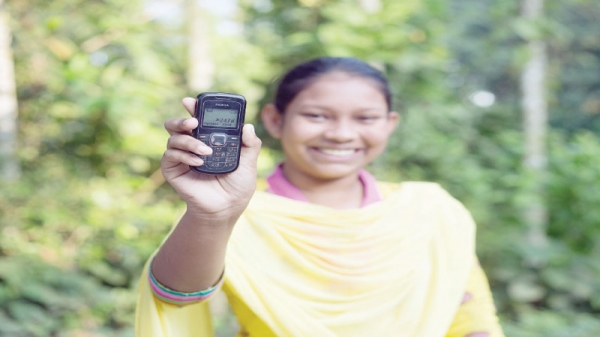
English (965)
Children categories
Rebuilding Livelihood of the Ebola Affected Petty Traders project
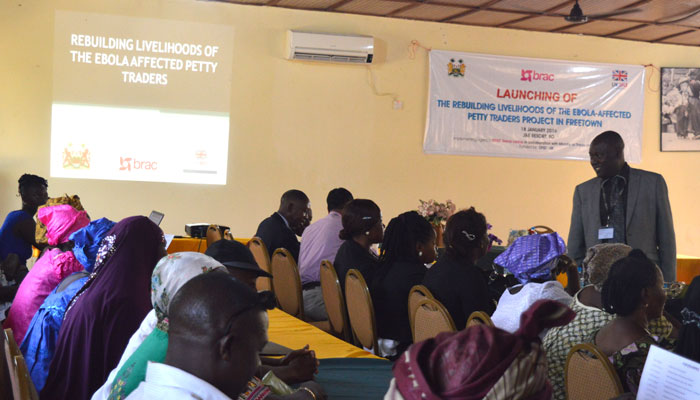
BRAC Sierra Leone in collaboration with the Ministry of Trade and Industry launched the Rebuilding Livelihood of the Ebola Affected Petty Traders project at Njala Venue, Freetown on 8 January. As part of the project, sensitisation sessions were rolled out in different parts of the country where the project will be implemented; briefing key stakeholders on the different components of the project and creating awareness.
The project is funded by DFID and executed by a consortium consisting of BRAC, World Vision, World Hope International and Catholic Relief Services (CRS). BRAC Sierra Leone will cover 12, 036 beneficiaries in 4 districts; CRS will cover 6,110 beneficiaries in 3 districts and World Hope International will cover 3,441 beneficiaries in 2 districts. The main objective of this project is to support 29,400 petty traders affected by Ebola through soft loan, start-up business capital and capacity building training. It also aims to recapitalise micro finance institutions to ensure access to finance by petty traders and also long term sustainability.
Mobile money in Bangladesh
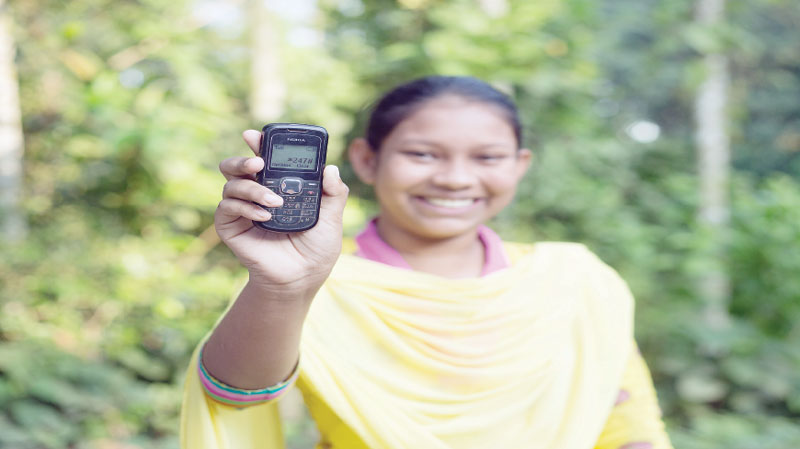
A Dhaka Tribune article by Hitoishi Chakma and Maria A May
In a recent Bloomberg interview, Bill Gates shares: “Banking is more fundamental than I realised. There have been attempts (at banking for the poor) by microfinance groups, cooperatives, but the transaction fees were always too high. Until we get those services down with very low fees and in digital mode, banking will only be for those who are better off.” In Bangladesh, where 95% of the population have access to mobile phones but only 20% have a formal bank account, the significance of such an opportunity for a banking revolution is even more pronounced. Indeed, since 2011, the Bill and Melinda Gates Foundation has made over $21 million in grants and equity investments in bKash.
Bangladesh has seen one of the world’s fastest growing mobile money ecosystems develop in the past two years. This growth has propelled bKash to become the second largest mobile money provider in the world, only behind Kenya’s mPesa. Ideally, this growth in digital money is also an opportunity for pro-poor financial service providers such as microfinance institutions to significantly expand financial access.
We are only to look at Kenya’s M-Shwari, that gives users instant access to short-term credit and secure savings for inspiration. As of 2015, one in five Kenyan adults are active M-Shwari customers. With the use of mobile money picking up here in Bangladesh, it is fast turning into an opportunity to ensure that everyone can enjoy the full benefits of banking products. Mobile money fees in Bangladesh, when comparing small transactions such as Tk400, are among the lowest in the world.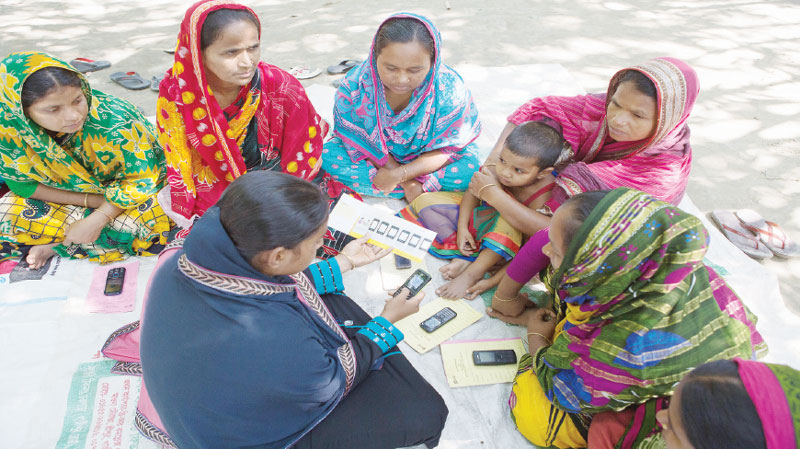
Yet for all the adoption of mobile money we have seen in Bangladesh, there remains one key segment of the population that has yet to embrace it - women, especially poor women living in rural areas. Despite the rich history of women’s participation in microfinance and savings groups, when it comes to mobile money, over 80 percent of the mobile money users turn out to be men. What explains this lag and what can we do about it? Especially when poor rural women can benefit immensely from access to such services that would enable easier remittances, create new savings mechanisms, and even make purchasing airtime hassle-free.
Since 2014, through the Gates Foundation-funded Innovation Fund for Mobile Money, BRAC has been piloting different projects in providing digital financial services for the poor. This experiment with mobile money aims to see how existing BRAC services can be transformed into more effective and valuable solutions for the poor. Over the past one-and-a-half years, these experiences ranged from providing digital microfinance in remote communities to offering flexible school fee payments that allows low-income parents to pay in small installments. Overall, the projects have targeted women and girls, focusing on their needs in products and financial education.
However, as we have found from the pilots, it is not easy for a rural woman to master mobile money. These women often report that they are satisfied with the ability to simply receive calls and may lack the basic numeracy skills required to navigate the mobile money menus. This has prompted us to begin providing financial education, where we provide basic numeracy skills and develop financial management skills. In places like remote Hatiya, where literacy levels are low, it can take three to six months of financial education before a woman feels confident carrying out her own transactions.
While this is a lot of work, it is easy to assume that women are lagging behind in adopting mobile money because of an information gap. Certainly, limited information and literacy create challenges, but in fact, the barriers to adoption go much deeper.
A recent exploration of the problem using human-centered design techniques solidified these convictions. One of the central comments heard repeatedly from women is that they do not identify themselves with becoming users of mobile money, which is the domain of the businessman. Additionally, many women lacked confidence in their ability to use the service preferring to use cash instead. This shows that, like most of us, they are present-biased and seek to avoid the immediate difficulties associated with learning to use the service even though it would bring them greater benefit in the future. By simply relying on agents their basic needs were being met and many commented on carrying out transactions with agents as “fine.” Fortunately, these issues can all be addressed, but not through traditional financial education. Instead, this requires more creativity from mobile money providers and NGOs on how they design their services.
What inspires BRAC the most is the increasing number of women from Hatiya to Panchargarh who, despite all of these issues, are now expert mobile money users, confidently buying airtime, making deposits into their savings accounts, and managing their remittances. Their needs superseded their unfamiliarity and fear of technology. Many received significant support from BRAC’s staff and/or local bKash agents, who they trust and can access as needed. Given the challenges of reading the English menu, many used rote memorisation through mnemonic techniques to make these transactions.
Ultimately, necessity drives innovation. Till date, despite the potential present, womens’ demand for mobile money in Bangladesh has not been activated. Reaching these women is a must, if a banking revolution is to be ignited for the poor through mobile money.
The original article can be found at: http://www.dhakatribune.com/feature/2016/feb/15/mobile-money-bangladesh#sthash.52aJVlqt.dpuf
BRAC Seed and Agro Enterprise
BRAC has been working in the agriculture sector since 1972. The objective is to enhance food and nutritional security by ensuring the consistent supply of quality agricultural inputs including resilient varieties, promoting sustainable production technologies and appropriate mechanisation to reduce post-harvest losses.
Quality seeds are one of the necessary factors for high yields. To ensure quality seed supply, BRAC has been marketing hybrid maize seeds since 1994, and hybrid rice seeds since 1998. It also started producing hybrid maize seeds in 1996-97, vegetable seeds in 1996, and hybrid rice seeds in 2001. BRAC has established the value chain system of production and distribution for seeds and other agricultural inputs, allowing the enterprise to offer fair prices to the farmers. BRAC Seed and Agro Enterprise focuses on supplying quality agricultural inputs, appropriate production and post-harvest technologies to enhance production and reduce post-harvest losses to optimise the profit of poor and marginal farmers. Additionally, it is important to BRAC to use sustainable methods, so that agricultural development does not occur at the cost of environment harmony.
BRAC Seed and Agro Enterprise today
BRAC Seed and Agro Enterprise has three agricultural research and development centres in Gazipur, Bogra (Sherpur) and Dinajpur (Birol). The centres are conducting applied research on plant tissue culture, vegetables, rice and maize. It has a soil-testing laboratory with the capacity of testing around 3,000 soil samples per year. Our researchers focus on discovering new varieties that meet the needs of both regional farmers and consumers. BRAC has developed five hybrid rice varieties, four hybrid maize varieties, 10 hybrid vegetable varieties and three open-pollinated vegetable varieties. It has registered 12 hybrid rice exotic varieties through government authorities.
With 22 production centres and about 7,000 contract farmers around the country BRAC is the country’s largest producer of hybrid maize seed and second largest producer of potato seed. It has the largest market share for rice seed (hybrid and high-yielding varieties), maize seed, potato seed and vegetable seed. The seed and agro enterprise has established five seed processing centres with a processing capacity of 12,000 metric tons per year, along with 11 modern storage systems with the capacity of 4,400 metric tons. To ensure high quality seeds, the enterprise uses automatic polymer seed coating treatment (fungicide) and an automatic packaging system. Furthermore, it promotes environment-friendly farming by marketing micronutrients like zinc and boron in order to tackle the rising micronutrient deficiency in soil.
BRAC’s seed and agro enterprise has built the value chain system of production and distribution through a wide network of 450 dealers and more than 4,500 sub-dealers around the country. BRAC Seed and Agro Enterprise is now marketing 26 hybrid varieties and 27 open pollinated varieties of vegetable seed, 13 hybrid varieties and 19 high-yield varieties of rice seed, 14 hybrid varieties of maize seed and 5 varieties potato seed. During the production season 2014-15, the enterprise has marketed 1,600 metric tons hybrid rice seed, 1,300 metric tons high-yielding varieties of rice seed, 590 metric tons hybrid maize seed, 125 metric tons vegetable seeds and 9,600 metric tons potato seeds. In the seed business, BRAC Seed and Agro Enterprise has 19% market share in hybrid rice, 23% in hybrid maize, 36% in potatoes (of organised seed supplied) and 8% in vegetables. In tandem, BRAC is also importing quality seeds regularly to increase the national production of high-yielding varieties invented across the globe.
Besides the core seed business, the seed and agro enterprise is currently working with two projects, ‘agri-business for trade Competitiveness Project (ATC-P) Bangladesh’, which ensures the availability of quality vegetable seeds at hard-to-reach areas and ‘SUSTAIN’, which aims to ensure nutrition-enriched orange flesh sweet potato production and promotion on chars and areas with salty soil and water. Previously, BRAC Seed and Agro Enterprise worked on the USAID Horticulture Project to improve incomes, nutrition and health in Bangladesh through the cultivation of potato, sweet-potato and vegetables. The enterprise also collaborated with CIP, under FoodSTART, for a project funded by IFAD to ensure food security through roots and tuber crops. Another project was conducted in collaboration with Katalyst, under Swisscontact, which involved the promotion of maize cultivation through increasing awareness, access to information and quality inputs in the southern region of the country in order to allow farmers to generate income.
At a glance
3 agriculture research and development centres
22 production centres
5 modern equipped seed processing centres with the capacity of 12,000 metric tons per year
11 modern storage system with the capacity of 4,400 metric tons
5 own developed hybrid rice varieties
4 own developed hybrid maize varieties
10 own developed hybrid vegetable varieties
450 dealers and over 4,500 sub-dealers in supply chain
Marketing 53 varieties of vegetable seed, 13 hybrid varieties, 19 high-yield varieties of rice seed, 14 hybrid varieties of maize seed and 5 varieties of potato seed
Marketing 1,600 metric tons hybrid rice seed, 1,300 metric tons inbreed rice seed, 590 metric tons hybrid maize seed, 9600 metric tons potato seed and 125 metric tons vegetable seed annually
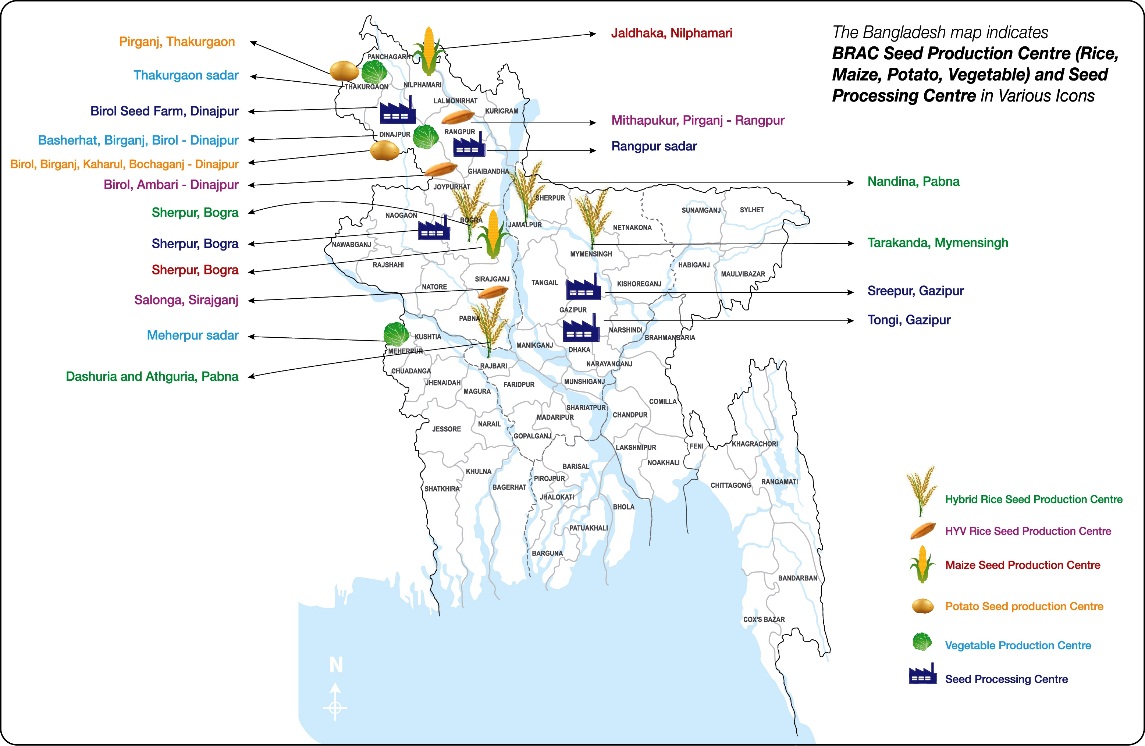
Primary education in Bangladesh goes digital

Prime Minister officially launches new interactive digital multimedia content to cover entire primary school curriculum
“Emphasis has been given to ensure taking tech-based education system to every corner of the country,” said Prime Minister Sheikh Hasina today at the official launch of the new, interactive digital multimedia content. The digital content covers the entire curriculum of primary education (grades 1-5) and will be accessible on any device.
“To improve the quality of education, we have developed this new interactive multimedia content that will be accessible from any corner of the country,” the PM said.
Through this initiative, all of Bangladesh’s twenty million primary school students will be able to access their entire curriculum online via any device. In public schools, it is being accessed on the computers that the government has already integrated into over 1,500 digital classrooms across the country as part of its Digital Bangladesh vision.
Promo video
Present as a guest Minister of Primary and Mass Education Advocate Mostafizur Rahman, MP said, “We have already prepared 55 PTIs with multimedia projectors and they have developed interactive content. They have also trained the teachers on the content. We are training teachers on the use of multimedia projectors, digital devices as well.”
The government initiated to transform 17 books made by National Curriculum of Textbook Board (NCTB) into interactive multimedia digital education content a decade back. The multimedia content creates an innovative and engaging learning environment, moving away from the traditional teacher-centric classroom.
It was developed in response to the success in classrooms of the content previously developed by BRAC to cover Grades 6-10. The new content was funded by the Government of Bangladesh and created by BRAC and Save the Children.
Explaining this as a revolutionary initiative, state minister of ICT Mr Zunaid Ahmed Palak, MP said, “The multimedia based interactive digital content is an approach to make education more interesting and fun for children. So far, we have made multimedia classrooms in 5,000/1500 schools and we plan to reach 65,000 by 2021, thus contribute creating a digital Bangladesh”
According to research, visuals improve learning by up to 400 percent, and now those visuals will be available anywhere in Bangladesh that an internet connection can be found. Every screen, in a country where over 50 million people are online, will now be a space where families can experience fun, animated learning.
Congratulating government BRAC founder and chairperson Sir Fazle Hasan Abed, KCMG said, “BRAC has always emphasised on education from its beginning. We started our “Computer aided learning” project in 2005 to bring technology in education sector. We appreciate the government for adopting our learning and taking it all over the country. It will change the education scenario in future”.
Amongst other distinguished guests, present at the event were secretary of primary and mass education Md. Humayun Khalid, secretary of ICT Shyam Sunder Sikder, Interim Regional Director South/ Central Asia of Save the Children Mr Michael McGrath.
Interactive multimedia content is available here: http://digitalcontent.ictd.gov.bd/
To find more about BRAC’s education porgamme visit: http://education.brac.net/
Watch the event coverage here: http://www.brac.net/live
BRAC won the Amplify/OpenIDEO Urban Resilience Challenge!
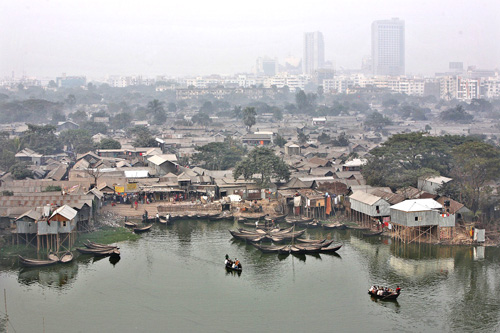
BRAC has won the Urban Resilience Challenge launched by Amplify/OpenIDEO. The idea submitted by the BRAC Urban Development Programme (UDP) for this challenge is among the 8 winning ideas which were selected from a total of 350 submissions globally. BRAC UDP’s idea involves developing community-led fire prevention and response mechanisms in the urban slums of Bangladesh.
OpenIDEO is an online collaborative that enables people from all over the world to collaborate in developing innovative solutions to pressing social and environmental challenges. OpenIDEO runs the Amplify programme which focuses on improving the lives of the billion people living in extreme poverty around the world.
Amplify will fund BRAC UDP up to 800,000 USD for a 12 months project. Amplify will also support BRAC UDP to build capacity on human-centred design approach to problem solving and develop prototypes.
The idea submitted by BRAC UDP for the Amplify/OpenIDEO Urban Resilience Challenge can be viewed in detail here -
https://challenges.openideo.com/challenge/urban-resilience/wining-ideas/community-led-participatory-disaster-management-system-to-reduce-risk-of-fire-hazard-in-urban-slums-of-bangladesh
NGO of the year
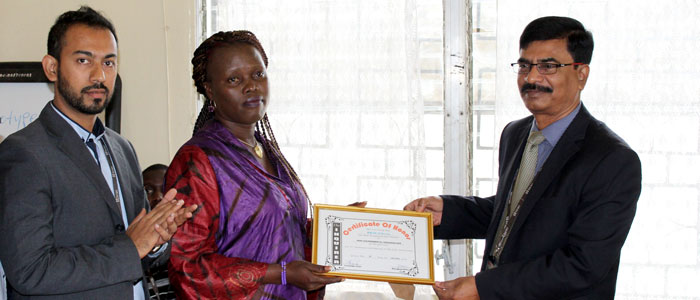
On 31 December 2015, the Inquirer newspaper awarded BRAC Liberia - the NGO of the year. This decision was based upon public entries sent to the newspaper along with the decision made by its editorial team. BRAC Liberia has been contributing towards improving the potentials of under-privileged people. It has been implementing development programmes in health, agriculture, poultry and livestock and microfinance sectors as well as scaling up reproductive maternal neo natal and child health services in the country.
BRAC Sericulture

Pioneering silk-farming in Bangladesh:
Bangladesh has a rich history of traditional textiles for many generations. When the country gained its independence, Sir Fazle Hasan Abed searched for income generating activities targeted towards people in rural areas living in poverty.
There was a high demand for silk in Bangladesh. Sir Fazle decided that the cultivation of silk is an opportunity for people to empower themselves out of poverty, keeping alive the tradition of silk rearing in the process. Thus, in 1978, BRAC started its sericulture project.
BRAC Sericulture is the only institute in Bangladesh which maintains the total chain of sericulture activities - from cultivating silkworm eggs to finished products. At present, 5,927 participants are under BRAC Sericulture Enterprise, involved in sericulture activities, including silkworm rearing and cocoon production, silk reeling, spinning and raw silk production, silk twisting, warping, dyeing and silkweaving.
BRAC Sericulture in the early days:
The sericulture project initially began by providing improved mulberry sapling to farmers, along with technical training for mulberry cultivation, silkworm rearing, and spun silk (endi lachi) production by paddle wheel charka spinning. The project also gave loans to farmers to lease land for mulberry plantations where they could rear silkworms. It ensured the supply of disease-free laying (DFLs) to silkworm rearers, which involved purchasing the cocoons from the silkworm rearers to ensure fair price. BRAC also provided cocoons to individual charka spinners and purchased spun silk. It provided secured employment and timely payments for the women involved in the industry. As the farmers did not have access to any stable credit facilities, BRAC created a reliable microfinance system to support them.
Challenges:
BRAC faced a number of challenges with this development programme, including low productivity of mulberry leaves, long lasting rainy seasons, low productive silkworm races and inability of farmers to pay back loans. High competition with imported silk from China led to disruption of our cocoon market.
The enterprise model:
Higher quality cocoons and increased productivity in farms propelled BRAC’s sericulture activities into an enterprise model. To ensure the fair price of raw silk, BRAC has developed a value chain from raw cocoon production farm to finished silk production. The finished products are marketed through Aarong.
BRAC Sericulture at a glance:
- Silkworm race maintenance and egg production centre 01 Nos
- Silkworm rearing and cocoon production farms 10 Nos
- Silk reeling and raw silk production centre 01 Nos
- Spinning and spun silk production centre 01 Nos
- Silk twisting and warping centre 01 Nos
- Silk weaving and silk fabrics production centres 06 Nos
- Marketing Through Aarong outlets
New initiatives:
BRAC has introduced two improved mulberry varieties named S1635 and Victory-1 to increase mulberry leaf production. Multi-bi hybrids and bi-voltine hybrids in silkworm rearing are being adopted to increase cocoon production and cocoon quality. BRAC Sericulture is working to improve silk quality and increase its volume of production by introducing bi-voltine silkworm race during favourable rearing seasons.
The enterprise is currently limited to cottage basin reeling machines to produce raw silk, and hand looms and power looms to produce silk fabric, which are being marketed mainly through Aarong’s outlets. Finally, BRAC Sericulture is increasingly focused on the improvement of raw silk quality and fine silk production.
Synergies with Aarong:
BRAC Sericulture has created a direct link with Aarong for the marketing of BRAC Silk and silk goods. Sericulture products such as silk sarees, dupattas, scarves and unstitched fabric are being sold directly through Aarong outlets.
At present, sericulture enterprise considers consumer preferences when diversifying silk products and developing new designs for products. The enterprise works regularly to improve the quality of its new and existing products. By Improving these areas Brac hopes to attain the additional goal of bringing BRAC’s sericulture products to global standards for exporting to international markets.
Download: Factsheet
BRAC Sanitary Napkins and Delivery Kits
Moreover, the health workers and health volunteers working at Shushastho (BRAC’s health centres all over Bangladesh) also recognised the great necessity for an assortment of medical kits which would facilitate safe births. As a response, BRAC initiated the production of the ‘Kollani Delivery Kits’ for rural women in 1999. They were similarly affordable, hygienic and bio-degradable.
Evolution of an enterprise
The production of the sanitary napkins and delivery kits was achieved by employing female members from BRAC’s targeting the ultra poor (TUP) programme, providing them with fair-wage employment in the manufacturing of sanitary products. Initially manufacturing started in one production house with 30 women from the TUP programme in the Kurigram district of Bangladesh. These products were not directly retailed to the target group, but rather were provided by the health workers and health volunteers, selling them for a small profit during their visits to households. Each health worker/volunteer is assigned 100 households in the villages that they serve. In order to distribute these sanitary products to a larger population across the country, production was increased and the enterprise was created in 2004.
Quality products at affordable prices
In order to ensure quality control, the production and expiry dates are always included on the packets. A packet of Nirapod Sanitary Napkins commercially retailed both in the rural and urban market since 2004, costs only BDT 50 (USD 0.64) or BDT 28 (USD 0.36) depending on size (large or small) and the Kollani Delivery Kit costs only BDT 40 (USD 0.52). The cost of these products is kept low by using carefully selected raw materials.
Livelihood opportunities for disadvantaged women in rural communities
Currently, 284 women and 2 men are working in the five production centres located in the Manikganj, Baniachang, Nilphamari, Gopalgonj and Kurigram districts of Bangladesh. Although still somewhat little-known in the urban market, the Nirapod Sanitary Napkins and Kollani Delivery Kits have been widely popular in the rural areas, and have also been commercially retailed in many hard-to-reach regions like Teknaf, Tetulia, and the Chittagong Hill Tracts.
Download the latest factsheet here.
BRAC Salt

Salinity for the rural poor and sustainable livelihood for farmers
Due to a lack of health awareness and malnutrition, many people from rural communities in Bangladesh suffer from various mineral deficiencies like iodine deficiency, which can cause diseases such as goitre and prenatal ill-health. When BRAC Salt enterprise was initiated in 2001 in the Cox’s Bazaar district of Bangladesh, iodine deficiency was acute amongst the rural population across the country and BRAC ventured into producing iodised salt to help curb this problem. BRAC enterprises are mostly known as pioneers in many sectors throughout Bangladesh and BRAC Salt is no exception. Its entry into the iodised salt market inspired many entrepreneurs to produce iodised salt as well.
However, addressing iodine deficiency was not the only motivating factor for BRAC to start operating as a salt enterprise. There was a much deeper mission, one that would ensure sustainable development by encouraging local salt farmers to continue on their income generating paths, especially in view of the supply deficiency for raw salt in Bangladesh which had compelled the government to import salt from other countries. However, BRAC's position on this was that if import of salt was allowed, then two things may happen: Bangladesh's salt market would be externally controlled and local salt farmers may even lose their livelihood due to competition. With this in mind, BRAC started producing salt and eventually convinced the government that there is now less need for imported salt.
BRAC Salt not only supports the salt farmers but also its consumers, who almost exclusively belong to the underprivileged social groups from the rural northern regions of the country.
People precede profit
Although BRAC Salt has had a significant social impact, as an enterprise it has faced some considerable setbacks. Firstly, it became difficult for BRAC to compete within the salt market as it did not want to follow the competitive practices because it would jeopardise its social impact. Moreover, the natural grey salt that it produced also lacked the refinement demanded by the urban population. Therefore, BRAC Salt lacked demand and a steady profit from the urban market, which adversely affected its sustainability. The management even considered closing down the whole enterprise, as it was only a small-scale business and the surplus it made was too small for any further expansion plans. However, taking into consideration over the 120 workers who are dependent on this enterprise for their livelihood, the management decided to downsize, rather than shutting down the entire operation. The enterprise is currently focusing on increasing efficiency and introducing new products to the market.
BRAC Salt today
One of the latest products BRAC Salt introduced into the market is Minamix, a supplementary cattle feed. Researchers at BRAC’s cattle-related enterprises and Bangladesh Livestock Research Centre (BLRC) realised that there was a mineral deficiency in the cows reared by rural farmers, which led BRAC and BLRC to co-create Minamix. It is essentially a high mineral-based salt, containing essential components lacking in the cows. It can be mixed directly into cattle feed, helping farmers raise healthier cows that will produce a higher yield of milk and meat. The challenge now lies in reaching out to rural farmers to educate them about iodine deficiencies in their cows and introducing Minamix. The enterprise is hopeful that once the targeted market recognises the benefits of this innovative product, BRAC Salt will get the chance to revive itself and be established once more as an innovative leader in the salt market.
BRAC Recycled Handmade Paper
The beginning and evolution
BRAC Recycled Handmade Paper (RHMP) was initiated as a Rural Enterprise Project (REP) in 2000 with an aim to help prevent environmental degradation by targeting the corporate urban market in Bangladesh to recycle their paper waste. On a different note, it was also introduced to support a small group of drop out female students from BRAC’s education programme by providing them jobs at the production facility of this enterprise.
Being a pioneer in the promotion and development of recycled handmade paper and paper products in Bangladesh, this project later evolved into an enterprise in 2009. Although there have been a few scattered producers of this product feeding the niche market and export industry of Bangladesh prior to the evolution of this enterprise, BRAC Handmade Recycled Paper happens to be the first entity to make a proactive approach by manufacturing and retailing the products in urban market under the brand name Kanon.
The present scenario
Today people are more environmentally conscious, and hence their response towards this enterprise is accelerating faster than ever. The idea of reducing paper wastages and modifying them into creative stationeries intrigue most people, and the satisfaction of contributing even a tiny portion to the environment happens to be a cherry on top. Today BRAC RHMP operates as one of BRAC’s three Green Enterprises, and produces synthesised paper products from recycled materials, such as, used papers, stalks of wheat, hay, water hyacinth, caustic soda, dye, barley, glue and cotton. These materials are gathered from various BRAC projects and branch offices, thus helping reduce the amount of waste produced by BRAC, and contributing toward employment generation for women and ‘going green’ initiatives nationwide in the process.
Creating opportunities
In addition to its committed contribution to the environment, BRAC RHMP has also been supporting the all-female employee group working at the production facility with unequivocal employment opportunities and fare wages. About 100 women are currently working at the production facility of this enterprise, located at Shombhuganj, Mymensingh, and their payments are made based on the quantity of products they put together. Hence the more products get sold in the urban market, the more income these women are able to generate. As these products are strictly handmade, more women are going to get employed at the production facility if the market demand increases. Apart from the workers, the customers belonging to the urban population group, especially the corporate offices also fall into the category of BRAC RHMP beneficiaries as they are actually able to reduce the wastage of paper by exchanging these with this enterprise, only to purchase brand new items manufactured by their own waste.
Change in goal/mission
The mission of the Recycled Handmade Paper enterprise has not changed, but rather modified and expanded. At first it was only to recycle and reuse the paper wasted by most of the corporate lines. But now it has started retailing its products at BRAC’s brand new green outlet named Kanon. An exchange offer is going on at present in which any corporate enterprise can deliver its wasted paper to RHMP to get them recycled so that these are bought back again by the same enterprise. This is playing a huge role in decreasing the wastage of paper in corporate offices and thus helping our environment in the process. In this offer, the RHMP collects the paper waste of corporate offices to modify and customise them into handmade paper or paper products as per their demand and sell it back to them. They can also place their orders from a range of products already offered by RHMP.
Future goals
The market for recycled handmade paper products is growing rapidly; hence it is more likely to be expanding in the near future. Introduction of a new, mechanised process in making the products is being planned. The mainstream paper products are going to be handmade as usual, but the now semi-mechanised production of paper is going to be mechanised to support a larger scale of production and meet the growing demand for recycled paper in Bangladesh. One of the most important goals are to make the handmade recycled paper and paper products more accessible in the urban market, thus providing more income generating opportunities for rural women.
Download: Factsheet
Join the world’s biggest family

